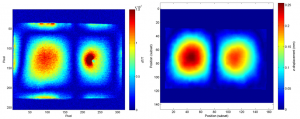Fibre reinforced polymer composites offer lightweight solutions, but are currently not used efficiently due to inherent defects resulting from the manufacturing process. Research at the University of Southampton has focused on developing intelligent NDE systems that show how the defect influences structural performance by utilising imaging techniques that measure strain.

In traditional NDE approaches such as ultrasound and thermography only the size and position of the defect are provided. The barrier to applying the imaging based techniques in service, for example on-board ships or on aircraft, is that to make a measurement it is necessary to impart a load so until now the techniques have been confined to the laboratory test environment. In 2012 a team lead by Professor Janice Dulieu-Barton was awarded £1M through a MATERA+ EU Action to develop an imaging system that could be used in service or at the production stage. Dr Richard Fruehmann developed the initial system which is based on imparting a vibrational load that can be developed without a test machine. (Richard received his PhD from the University of Southampton in 2009.)
The underlying technique was based on infra-red imaging and enabled full-field high resolution data to be captured in a matter of seconds. An example of a data set from a carbon-epoxy aircraft panel is shown in Figure 2. To derive more information about the structural performance it was necessary to employ a further measurement technology known as digital image correlation (DIC). Typical DIC tests involve tracking the deformation between two load states, so that the displacements and hence the strain can be obtained. In vibrational loading conditions it is difficult to apply the technique because of the high loading frequencies involved, so a new approach was invented by Richard and Janice called ‘Lock-in DIC’ (LIDIC) which enables high resolution displacement and strain data to be derived from a structure undergoing cyclic loading. The approach has been demonstrated on specimens subjected to fatigue loading. A recent publication describes fully the work (click here).

The next stage in the process is combining the infra-red and LIDIC techniques obtain data from a structure subjected to vibrational loads. Dr Rachael Waugh received her PhD in 2014 where she established novel approach to the application of the thermography to NDE of joints in Liquefied Natural Gas carriers. The project was sponsored by Lloyds Register Foundation. Rachael has received an EPSRC doctoral prize fellowship to pursue the research started in her PhD and is now incorporating the LIDIC into her inspection methodology. The approach has been demonstrated, in the Testing and Structures Research Laboratory, on a vibrating flat panel as shown in Figure 3.

At present the LIDIC/infra-red approach is being developed in conjunction with long term industrial collaborators LA Vision with a view to developing a user friendly tool. Further work will focus on applying the technique to electricity generating plants with site visits planned to a conventional power station for trials.
